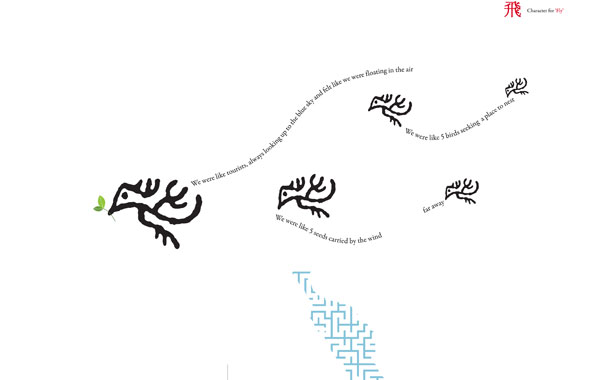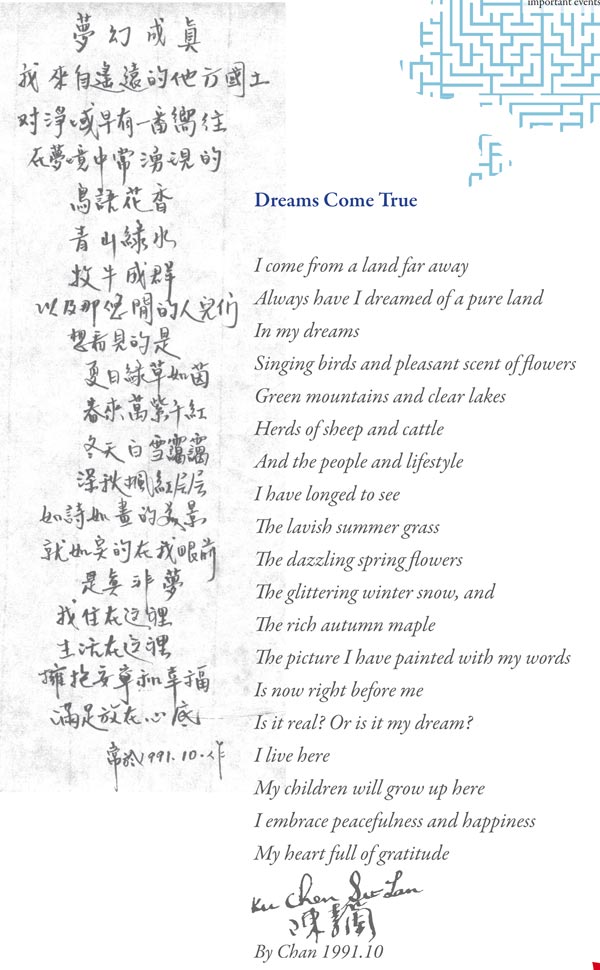Graphic Design as Art – Part 2/6
Permanent UV ink on canvas, 50cm x 100cm, scroll bound contemporary Chinese style

Visual Work – Sections on Close Up
Chinese Pictograph for ‘Fly’ ‘飛’
As you can see the character is a drawing of a bird.
Introduction to Chinese Calligraphic Scripts (Chinese Fonts)
Chinese character for ‘Home’ ‘家’
This script is also known as ‘bronze-inscription’ and ‘belland-tripod inscription’. Most Chinese people use a name seal instead of signature as their proof of identity. The following is an example of how the Chinese character for ‘home’ would be engraved on a seal. It looks like a maze.
 2. 草書 Ts’ao-Shu (Draft Script)
2. 草書 Ts’ao-Shu (Draft Script)
This script is literally a form of shorthand in which the characters are rendered in dots and short strokes. It originated in the second century B.C. and matured by the third and forth centuries. Because of its abbreviation which makes it difficult to read, this script is mainly used by scholars.
Several words can be linked in a continuous line and extended for a whole column without the brush being lifted from the paper. This style is highly expressive and has an abstract quality.
 3. 行書 Hsing-Shu (Action Script)
3. 行書 Hsing-Shu (Action Script)
This can also be called walking or running script. In using this kind of script, the speed of execution, or brush movement is slower than that of the Draft Script, which makes this script easier for the layman to read. Most people use it for handwriting to express individual personality and style.
 4. 隸書 Li-Shu (Clerical Script)
4. 隸書 Li-Shu (Clerical Script)
This script is also known as ‘Official’ or ‘Documentary’ script. It emerged in the Ch’in and Han period (221 B.C. to A.D. 221), and was simplified from Chuan-Shu for the purpose of clarity in reading and ease of writing. People in the past used this script to record history and important events.
 5. 甲骨文 Chia-ku-wen (Oracle Bone Inscription)
5. 甲骨文 Chia-ku-wen (Oracle Bone Inscription)
This is the most ancient script. The earliest known examples of this engraved script date from the fourteenth century B.C. and lasted to the eleventh century B.C.. They were hand-carved on animal bones and tortoise shells and derived from simple drawings of objects; ‘home’ is an animal sleeping inside a cave.
A poem written by my mom when we first arrived in New Zealand.
Written Documentation: Chapter 2 – Setting New Roots
We had five heavy suitcases with us and each of us carried a small handbag. I even carried my own tennis racket on my back. By the looks of our heavy loads of luggage it was quite obvious that we were going to stay for a long time, wherever our destination was. I was thirteen years old, my sister was fourteen and my younger brother David was nine. We bravely headed towards the turning point of our lives, and were ready to fly away to a brand new future, New Zealand.
We arrived on this green island in October 1988. It was springtime here while in Taiwan it was about to turn winter. Although it was springtime, we still found it cold here especially during early mornings and nights. Everything was fresh but strange at the time of arrival; I heard people speak but couldn’t understand what they were saying. All sounds and voices were fresh to my ears. Soon I realized that this was English, a language we desperately needed to learn. At the beginning, drawing pictures, smiles and body gestures were our only means of communication… Continue reading >>




